|
 Guitar
#043 Guitar
#043
Black Locust 12th fret OO size acoustic
Completed July 26, 2018
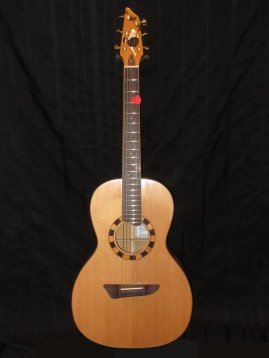 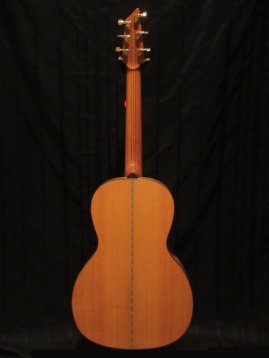 Some
of you may have seen my garage full of salvaged local trees, with Black
Locust included in the pile. I plan on marketing that wood in a few years
and this guitar is the "proof of concept" instrument. Some
of you may have seen my garage full of salvaged local trees, with Black
Locust included in the pile. I plan on marketing that wood in a few years
and this guitar is the "proof of concept" instrument.
You will almost never
find a guitar made of Black Locust, yet this species of tree is closely
related to two of the traditional woods -
Rosewood and Koa - used for making guitars. It is literally a first
cousin! And as such, has many overlapping qualities making it a very
viable alternative to especially the rosewoods. However contrary to the
norm, this is not a dark coloured wood, it is Gold in color, with gold
sparkle when it is in bright light. Rosewood is just too dark
to pick up those same reflections even though it is similar in structure.
Together with the great tonal qualities, I consider this woods Canada's
Golden Tonewood.
For guitar builders, this wood bends even easier
than Rosewood, and with less blunting effect on tools, and with better
glue holding properties. It's just an accident of guitar history that it
has not been used. But now that Rosewood is over harvested all over the
world, and now has international CITES restrictions, guitar builders will
need to look around for alternates. This guitar is an example of how good
our Canadian Black Locust is, and with no environmental problems
associated.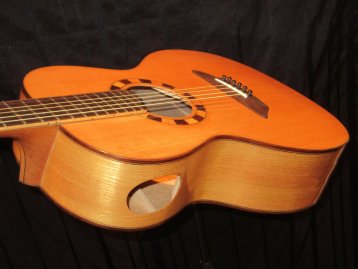
This is a small body guitar - using the Martin
naming system - it is a OO size body. and with a 12th fret neck joint like
an older style instrument. Most guitar have the neck joint at the 14th
fret, while most electric guitars are joined around the 16th. Yes, that
makes a huge difference.
This guitar has a Sitka top, African Mahogany
neck, East Indian Rosewood fret board, Black Locust back and sides.
A design detail here is the use of Indian Rosewood binding in contrast
with the Black Locust back and sides. Both have very different colors but
the secondary tones work well together. The fret board and bridge are also
Indian Rosewood, thus tying it all together visually. The rosette is
alternating Black Locust and Rosewood.
That hole on the side of the
instrument is call a Sound Port, and is a feature of most custom acoustic
guitars now a days.
Again, look how those medullary rays shine!
I like to bring wood from the back of the instrument to the front, so in
this case, the background of the inlay image is also Black Locust.
The Chickadee is made of white Mother of Pearl and Ebony, while the Black
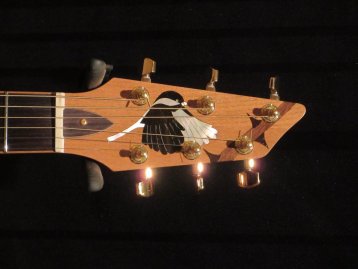 Locust
twig (yes it has thorns like this) is Black Walnut, with the thorns made
of Katalox. Locust
twig (yes it has thorns like this) is Black Walnut, with the thorns made
of Katalox.
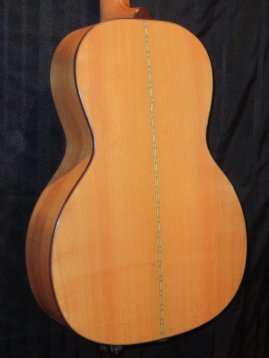 Black
Locust is very yellow when freshly cut, sometimes showing hints of brown,
or pale green, or even faint red, then aging to a more golden color. Black
Locust is very yellow when freshly cut, sometimes showing hints of brown,
or pale green, or even faint red, then aging to a more golden color.
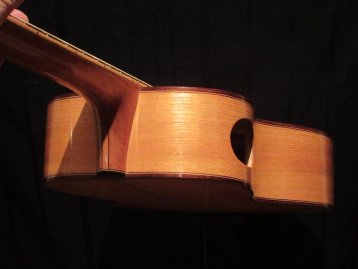 Wood
has cells across the grain that keep the wood from separating the way an
onion will. Those cell are called "Medullary Rays". Those are what pick up
the light and reflect it, and shimmering as the instrument is moved
around. Wood
has cells across the grain that keep the wood from separating the way an
onion will. Those cell are called "Medullary Rays". Those are what pick up
the light and reflect it, and shimmering as the instrument is moved
around.
The neck is African Mahogany with three black pin lines,
for a 7 laminate sandwich construction. I like to include a volute on many
of my guitars for a nicer feel at the head stock joint. The tuners are
gold Schallers (Made in Germany).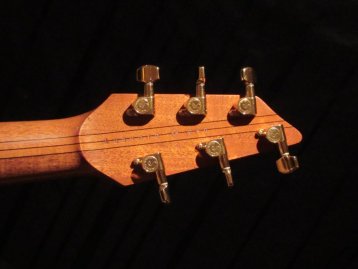
|
![]()
![]()